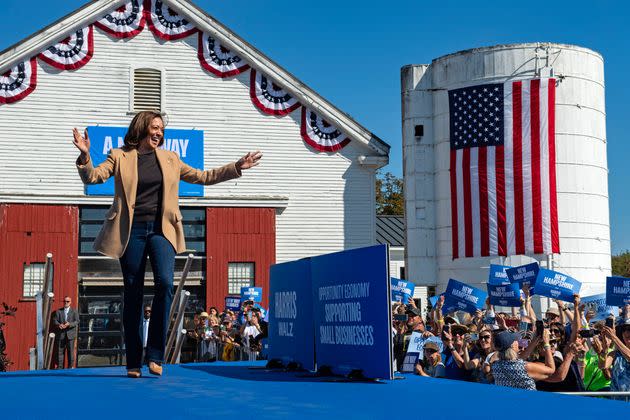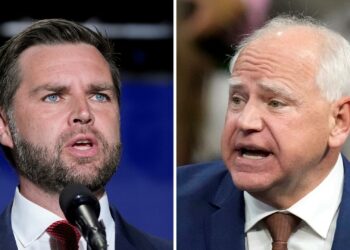Donald Trump is vowing to enact policies if he is elected president in November that would benefit voters’ pocketbooks, while offering few details as to how he plans to pay for them — a series of campaign promises that fly in the face of longstanding Republican Party orthodoxy about fiscal prudence and small government.
Last week, Trump announced that the government would pay for the costs of fertility treatments like in vitro fertilization, which can run to tens of thousands of dollars per cycle, if he becomes president again. He has also proposed eliminating taxes on workers’ tips and on Social Security benefits, which nonpartisan scorekeepers say would add hundreds of billions of dollars to the deficit. His campaign has not said how he intends to pay for these ideas.
Coupled with his plans to extend key parts of his 2017 tax cut bill and cut corporate taxes even more, Trump’s policy blueprint would add nearly $6 trillion to the deficit over 10 years, according to a Penn Wharton Budget Model analysis.
Trump’s plans amount to handing out what now-Utah Sen. Mitt Romney, who lost to former President Barack Obama in the 2012 presidential race, once decried as “gifts.” Trump’s rhetoric shows how he has transformed the party from one which at least touted fiscal responsibility — even if the national debt actually skyrocketed under the last two GOP administrations — to one in which the presidential nominee is free to do whatever it takes to win.

Former US President and Republican presidential candidate Donald Trump gestures as he speaks during a rally at 1st Summit Arena at the Cambria County War Memorial in Johnstown, Pennsylvania, on August 30, 2024. ROBERTO SCHMIDT via Getty Images
Trump making lofty campaign promises is nothing new. During his 2016 run, he pledged to build hundreds of miles of wall on the southern U.S. border if elected, and to make Mexico pay for it. Mexico did not pay; the U.S. government picked up the tab for the sections of border barrier he was able to build. Trump also promised to repeal and replace the Affordable Care Act with a “much better” health care program. That also never came to pass.
What is noteworthy about Trump’s second run for the White House, however, is his focus on wooing two critical voting blocs for Democrats: women skeptical of his stance on abortion rights and Black and Latino working-class voters. Vice President Kamala Harris, for example, quickly endorsed eliminating taxes on tips last month shortly after Trump did so, an acknowledgement of the idea’s popularity with union workers in Nevada and in other states.
“Trump doesn’t have firmly grounded roots in policy development, developed over many years working with conservative leaders,” GOP strategist Kevin Madden, who served as an adviser to Romney’s 2012 presidential campaign, told HuffPost on Wednesday. “He’s transactional, approaching his audience the same way any real estate professional or salesman would.”
“Both Harris and Trump are under enormous pressure to compete for the remaining sliver of swing voters,” he added. “Their strategies aren’t very different, in that they’re addressing the top issues like inflation, housing and health care by making big promises that poll really well, even though the costs and prospects for turning those promises into actual legislation may be out of reach.”
Harris, meanwhile, has proposed more generous child and earned income tax credits to support families, and payments for Americans to make housing more affordable, insisting that the return on investment these policies would have for the economy would make them functionally pay for themselves. But since she supports rolling back some of Trump’s 2017 tax cuts and raising the corporate tax rate, her agenda is estimated to cost substantially less than that of her GOP rival: about $1.7 trillion over 10 years.
Whoever wins in November will have to deal with making their fuzzy election promises reality by working with Congress to craft legislation. Lawmakers must decide whether and how to extend Trump’s tax cuts, which are set to expire next year for individuals, as well as agree to raise the debt limit — two difficult tasks that will almost certainly require horse-trading on both sides of the aisle.
Over the weekend, some of Trump’s allies on Capitol Hill signaled resistance to his plans to have the government pay for IVF or mandate that insurance companies cover the treatment. Sen. Lindsey Graham (R-S.C.) told ABC’s “This Week” he would not support the idea, suggesting providing Americans with a means-tested tax credit to help them pay for IVF instead.
Sen. Markwayne Mullin (R-Okla.), meanwhile, expressed concern about such a policy’s impact on the deficit. “There’s going to be an issue on how you pay for it. There’s always that issue,” he said on CNN.
North Dakota Gov. Doug Burgum dismissed the idea that either candidate will be able to fulfill their campaign promises for new government programs if they don’t win total control of Congress.
“There aren’t going to be any mandates, there aren’t going to be any free giveaways from Harris, unless one party or the other has got control of both chambers, so a lot of this is election talk and posturing,” he said in a separate interview on CNN.


US Vice President and Democratic presidential candidate Kamala Harris gestures as she arrives to speak at a campaign event at the Throwback Brewery, in North Hampton, New Hampshire, on September 4, 2024. JOSEPH PREZIOSO via Getty Images
With less than three months to go until the November election, both campaigns are more focused on the here and now: winning votes and motivating people to go to the polls. That’s why the candidates are eschewing the details in favor of an agenda they say will help cost-conscious voters save money, especially at a time when high prices remain top-of-mind.
“Election promises can be more or less explicit. The more explicit they are, the more it looks like the candidate is trying to buy votes,” warned Todd Belt, a professor at George Washington University and director of its political management program.
“‘Lowering the capital gains tax rate’ or ‘lowering the corporate tax rate’ are less explicit promises that don’t need to be explained to the constituency they benefit. But the constituency certainly knows, and these promises fly below the radar,” he continued.
Whether a campaign idea counts as a “gift” depends on how easily voters can see who benefits from it, Belt added. “Promises aren’t new, but how they are discussed varies.”
Trump and Harris will get an opportunity to discuss their campaign proposals during their first presidential debate, to be hosted by ABC News in Philadelphia on Tuesday.
Related…
Source link : http://www.bing.com/news/apiclick.aspx?ref=FexRss&aid=&tid=66d99bf1cb574c8385e4f4a4798252b7&url=https%3A%2F%2Fnews.yahoo.com%2Fnews%2Fdonald-trump-promising-voters-free-094510188.html&c=4416332208282774129&mkt=en-us
Author :
Publish date : 2024-09-04 22:45:00
Copyright for syndicated content belongs to the linked Source.







